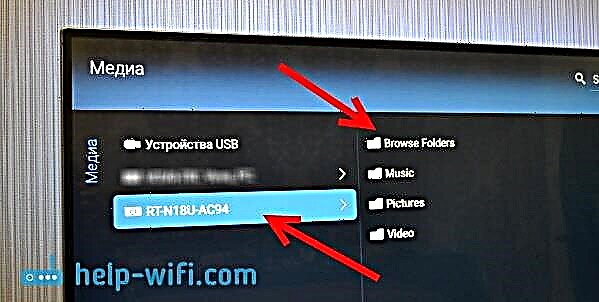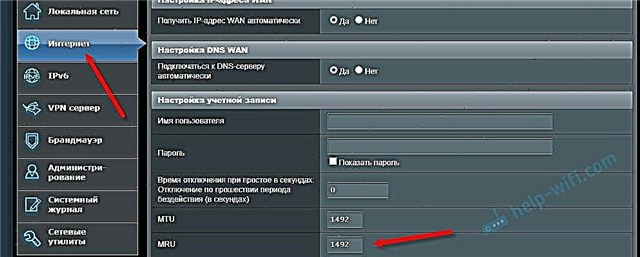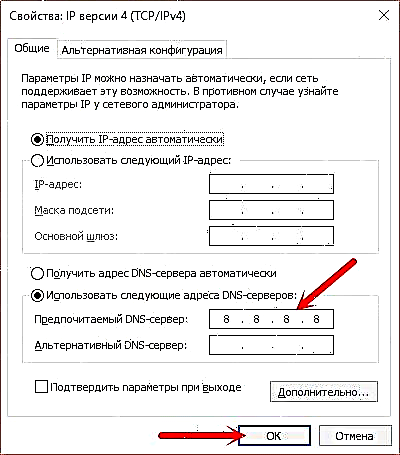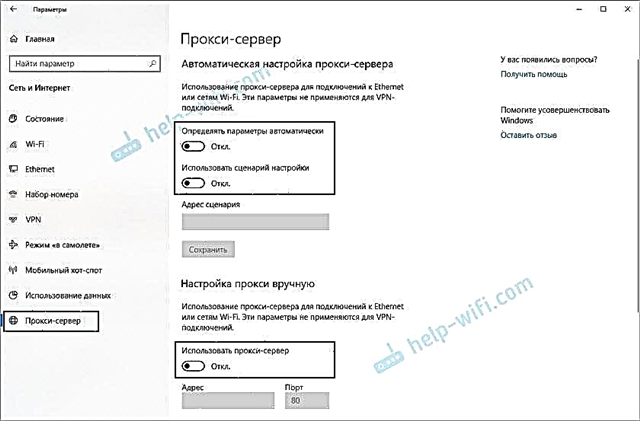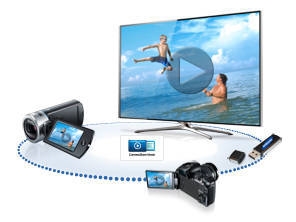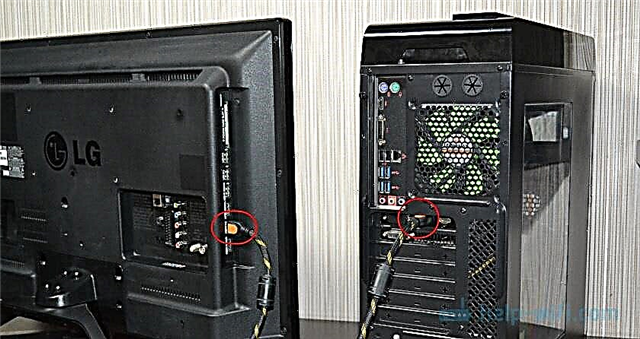I decided to prepare a separate article in which to tell in detail and show by example how to connect a TV to an ordinary stationary computer using an HDMI cable. The topic is relevant, and I am often asked about it. In fact, nothing is complicated. But there are some nuances that we will try to understand within the framework of this article.
Almost every, not even the newest, TV has at least one HDMI input. And in the computer, on the back of the system unit there is an HDMI output. This means that we can easily connect a PC to a TV using a regular HDMI cable, which can be bought in every digital equipment store.
Why connect them? Everything is very simple. The TV can work as a monitor. That is, you can display the image from the computer on the TV screen. The TV can be used as a main monitor or as a second monitor. This means that the image from the PC will be displayed on the screen of a conventional monitor and TV at the same time. Or just on TV. It already depends on your tasks. It should be noted that not only image, but also sound is output via HDMI.
I myself, and other users, most often connect a PC to a TV to watch movies on a big screen, or to play. You can also connect a gamepad to your computer and play on the big screen. Some people use televisions instead of monitors. They work with documents, surf the Internet, etc. But it seems to me that this is not very convenient. And the eyes get tired faster. For constant work at the computer, it is better to use a monitor. And connect the TV to watch movies, photos, games, etc.
The connection process will be the same for TVs from different manufacturers: LG, Samsung, Sony, Philips, Panasonic, Ergo, Hitachi, etc. In the same way, there will be no big differences in Windows settings. Yes, the settings in Windows 10, Windows 8, Windows 7 are slightly different, but not critical. I'll show you everything.
If you have a laptop, then you can do everything according to this article: how to connect a laptop to a TV via HDMI.
Preparation: check the HDMI ports on the TV and computer, choose the cable
First, we need to check if our devices have the required ports. We also need an HDMI cable to connect. Let's take a closer look at everything. If you have everything, then you can go directly to the connection and configuration.
- HDMI input on the TV is usually on the side, or on the back (sometimes, here and there). They must be signed and numbered. They look like this (Philips on the left, LG on the right):
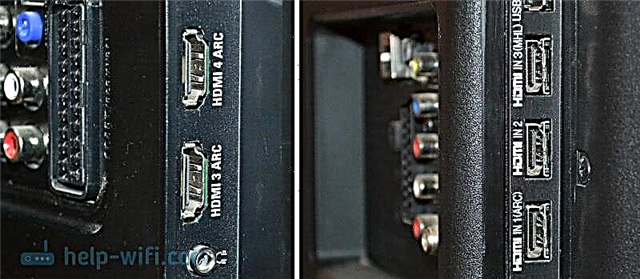 If your TV has at least one such port, then everything will work out.
If your TV has at least one such port, then everything will work out. - Then take a look at the back panel of your computer (I have to enter the system unit). There we need to find an HDMI output. HDMI can be either on the motherboard (integrated graphics on newer boards) or on the video card. But, even if you have this port on the motherboard (as I have in the photo below), and there is a separate discrete video card with HDMI output, then the TV must be connected to the video card.
 I took a photo of the system unit in a horizontal position. In my case, the TV can be connected to the HDMI output on the video card. If your computer does not have HDMI output, but does have DVI, then you can buy a DVI-HDMI adapter. And if there is only an old VGA, then you can also use a VGA-HDMI adapter, but then the sound will not be output to the TV, since VGA is not a digital output. If you want to connect a TV and a monitor to your computer at the same time, you will need either two HDMI, or HDMI and DVI. We also need the appropriate cables.
I took a photo of the system unit in a horizontal position. In my case, the TV can be connected to the HDMI output on the video card. If your computer does not have HDMI output, but does have DVI, then you can buy a DVI-HDMI adapter. And if there is only an old VGA, then you can also use a VGA-HDMI adapter, but then the sound will not be output to the TV, since VGA is not a digital output. If you want to connect a TV and a monitor to your computer at the same time, you will need either two HDMI, or HDMI and DVI. We also need the appropriate cables. - HDMI cable must be of the required length. If I'm not mistaken, they are up to 20 meters. If you do not have a separate cable, you can use the one that connects the monitor. If you have it connected via HDMI. I have this cable:
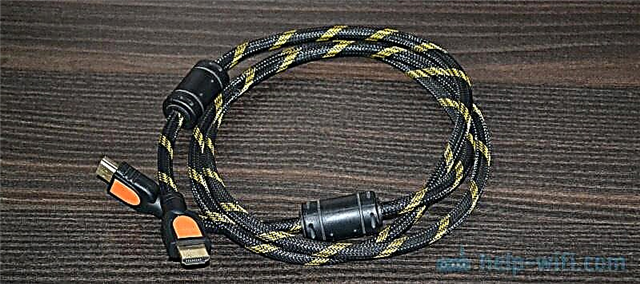 The most common, inexpensive cable.
The most common, inexpensive cable.
If you have ports on both devices and have a cable, then you can connect.
We connect the TV to the computer using an HDMI cable
You just need to take a cable, connect it to the HDMI output on your computer and to the HDMI input on your TV.
Important! Devices must be connected when they are off and power off. There is a risk of burning ports. There are such cases.
If you connect the TV as a monitor, that is, a single screen, then the circuit will look something like this:

Let's also consider another case when a TV and a monitor will be connected at the same time.
TV as a second monitor for PC
The monitor can also be connected via HDMI (as I have in the photo below), via DVI, or even via VGA. As a result, two screens will be connected to the PC.

We figured out the connection. Most likely, in your case, there will already be a system unit with a monitor connected to it. And all that needs to be done is to connect another TV to it.
Select HDMI input as a signal source in the TV settings
Most often, after connecting and turning on the devices, there is no image on the TV. An inscription like "No signal", "No signal source selected" or something like that will appear. You need to select a signal source on the TV. The port where we connected the cable.
For this, your TV remote control must have a separate "SOURCES" or "INPUT" button.

After clicking on it, a menu should open in which you can select a signal source. You can see which port on the TV you connected the cable to (each port has its own number). Or just select an active source. The actual process may differ depending on the TV. I have an old LG.

An image from the computer should appear on the TV. This will be either a copy of what is displayed on the monitor (if any), or a clean desktop (expand).
The main thing is that the picture from the computer appeared on the TV screen. Further, in the Windows settings, we can already change the image display mode. There are several of them.
Setting up an HDMI-connected TV in Windows
The screen resolution is adjusted automatically in most cases. So in the Windows settings, we can only change the mode of operation with multiple displays. This is only relevant when a monitor and TV are connected to the PC. If there is only one display, then these settings are not needed.
The easiest way to change the mode in Windows 10, Windows 8 and Windows 7 is a keyboard shortcut Win + P.

After clicking on them, the "Project" menu will appear. In the top ten it looks like this:

In Windows 7 like this:

Let's take a closer look at each mode.
In most cases, these settings are sufficient.
Additional screen options
To open them, just right-click on an empty area of the desktop. In Windows 10, select "Display Settings", and in Windows 7 - "Screen Resolution".

A window with settings will open, where you can see how many screens are connected to the computer.

You can also define them (by clicking on the "Define" button), change the resolution of each screen and the operating mode (which I talked about above).

In Windows 7, the settings of a TV connected via HDMI look like this:

With the image setting on the computer sorted out.
What if the sound from the computer is not going to the TV?
This happens very often. The image appears on the TV, but there is no sound. It does not exist at all, or it sounds from a speaker system connected to the computer. If you want the sound to go through the TV, then the first thing to check is that the sound on the TV is not muted or twisted.
Then you need to go to "Playback Devices".

Your TV should be in the device list. You need to right-click on it and set "Use as default".

If the TV is not in the list, then right-click on an empty area and check the boxes next to two items: "Show disconnected devices" and "Show disconnected devices".

If this does not help, and there is still no sound from the PC on the TV, then try reinstalling the video card driver. Just download it and run the installation. Let the HDMI cable be connected to the computer at this moment.
How to check these settings in Windows 7, I showed in the article Why is there no sound through HDMI on the TV when a laptop (PC) is connected. Be sure to watch it and read the comments. There is a lot of useful information there.
I have never encountered the problem of audio output via HDMI. How many I connected, everything worked immediately after connecting. But there is such a problem.
Connect 4k TV to computer. Ultra HD over HDMI
If you have an Ultra HD TV (aka 4k) and the video card supports this resolution, then there is a chance to get a beautiful and clear image. I checked, everything works. I have a 4k TV from Philips. And in the computer video card GeForce GTX 750Ti, which supports resolution up to 4096x2160
There are a lot of nuances. I'm not a gamer, so I'll try to explain as best I can. The fact is that you can display a 4k image via HDMI, and I did it. But most likely we will get a refresh rate of 30 Hz. Which is very little. To get 60Hz, we need a video card with HDMI 2.0 and the same cable. That is why they use DVI cables to connect to 4k monitors. And I have not seen something in DVI TVs.
I connected everything, started up the computer, and saw that the image on the TV was somehow strange, wrong colors. Perhaps this is only in my case.

Everything can be solved very simply. First, I tried to disable UHD (Ultra HD) for the HDMI port to which the PC is connected in the TV settings. The image is normal, but the resolution is normal, 1920x1080. Therefore, this method is not very suitable for us.
To get a real 4k image with natural colors, you just need to change the screen resolution to the maximum 3840x2160 in the display properties in Windows 10.

The image immediately became normal. The scale was also automatically set to 300%. Otherwise everything would be very small. It can be changed if necessary. I have not tried to play at this resolution. But I think it's not real. Moreover, the video card on my computer is not the newest and most powerful.
I look forward to your comments. Ask questions and don't forget to share tips. Good luck!

 If your TV has at least one such port, then everything will work out.
If your TV has at least one such port, then everything will work out. I took a photo of the system unit in a horizontal position. In my case, the TV can be connected to the HDMI output on the video card. If your computer does not have HDMI output, but does have DVI, then you can buy a DVI-HDMI adapter. And if there is only an old VGA, then you can also use a VGA-HDMI adapter, but then the sound will not be output to the TV, since VGA is not a digital output. If you want to connect a TV and a monitor to your computer at the same time, you will need either two HDMI, or HDMI and DVI. We also need the appropriate cables.
I took a photo of the system unit in a horizontal position. In my case, the TV can be connected to the HDMI output on the video card. If your computer does not have HDMI output, but does have DVI, then you can buy a DVI-HDMI adapter. And if there is only an old VGA, then you can also use a VGA-HDMI adapter, but then the sound will not be output to the TV, since VGA is not a digital output. If you want to connect a TV and a monitor to your computer at the same time, you will need either two HDMI, or HDMI and DVI. We also need the appropriate cables. The most common, inexpensive cable.
The most common, inexpensive cable.
